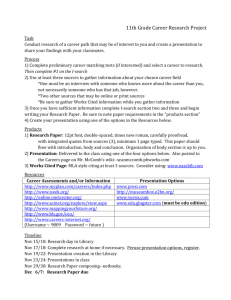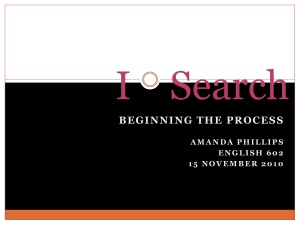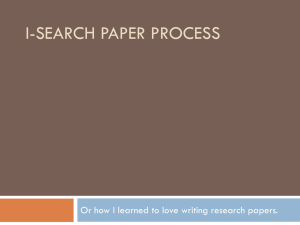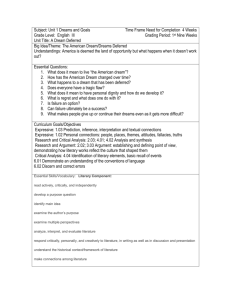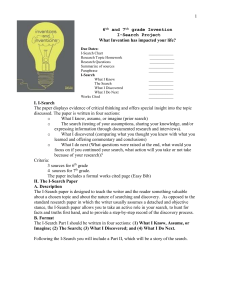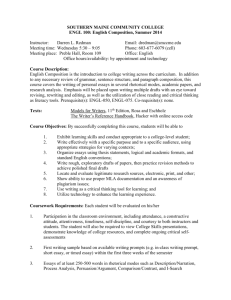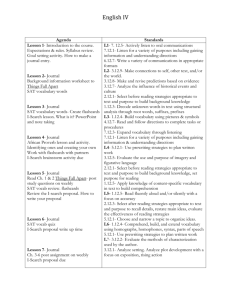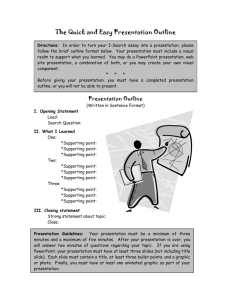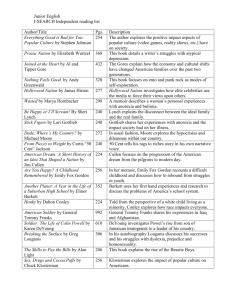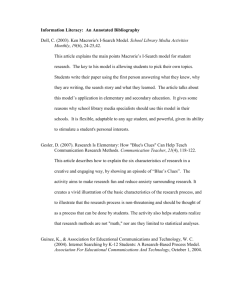I-Search Paper Guide Name _____ Spring 2012 You will be
advertisement
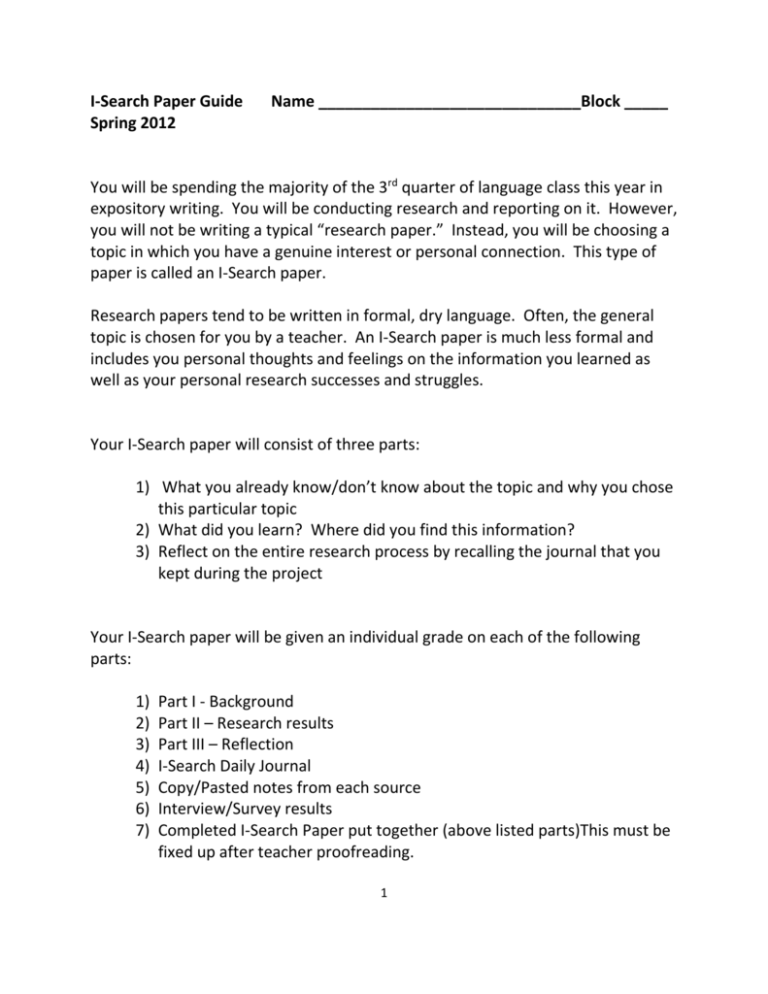
I-Search Paper Guide Spring 2012 Name ______________________________Block _____ You will be spending the majority of the 3rd quarter of language class this year in expository writing. You will be conducting research and reporting on it. However, you will not be writing a typical “research paper.” Instead, you will be choosing a topic in which you have a genuine interest or personal connection. This type of paper is called an I-Search paper. Research papers tend to be written in formal, dry language. Often, the general topic is chosen for you by a teacher. An I-Search paper is much less formal and includes you personal thoughts and feelings on the information you learned as well as your personal research successes and struggles. Your I-Search paper will consist of three parts: 1) What you already know/don’t know about the topic and why you chose this particular topic 2) What did you learn? Where did you find this information? 3) Reflect on the entire research process by recalling the journal that you kept during the project Your I-Search paper will be given an individual grade on each of the following parts: 1) 2) 3) 4) 5) 6) 7) Part I - Background Part II – Research results Part III – Reflection I-Search Daily Journal Copy/Pasted notes from each source Interview/Survey results Completed I-Search Paper put together (above listed parts)This must be fixed up after teacher proofreading. 1 A. _____Choosing a Topic Choose a topic that has immediate relevance to your life – a topic about which you have a genuine need or a real desire to know more about. You should have a personal connection to the subject. Use some of these trigger phrases to help you determine a possible topic. 1) I always wanted to know how to _____________________________. 2) When I daydream in class, I’m usually thinking about _____________. 3) I’ve always wondered how __________________________________. 4) Someday I want to travel to __________________________________. 5) I think _________________ is important because _________________. 6) What is important to you? ____________________________________. 7) What really get you mad? ____________________________________. 8) What can you literally spend hours talking about or doing? __________. 9) What television channels do you stop at when you are flicking through the channels. Why? __________________________________________. My topic is __________________________________________________ 2 B. _____ Narrowing Your Topic Once you have a topic determined, you need to focus on one key aspect of your topic. The best way to do this is to form a research question. This research question should not be able to be answered with a simple word or two. This research question should give way to several more detailed questions on the same topic. This, then, is the information that you will be attempting to answer through research. Research Question: ____________________________________________ _____________________________________________________________ Sub-questions: ________________________________________________________ ________________________________________________________ ________________________________________________________ ________________________________________________________ ________________________________________________________ 3 _____C. Writing Part I: Background Information Writing Part I is fairly easy. Your audience is your classmates and your teacher. Because you want your readers to understand and appreciate your research, you need to fill them in on your purpose and reasoning behind choosing your topic. You also need to tell them what you already know or don’t know on your topic. Also tell your audience what your research question and sub-questions are and why you chose them. This section should be approximately two paragraphs long. Here are some things to keep in mind. 1) Make sure you start your paper with a good “lead.” Starting an ISearch paper with the sentence, “I want to learn more about how tornadoes form” does not invite the reader to continue reading. Instead, start Part I with a quote, an intriguing thought or fact, or a question. 2) Make sure you clearly state your research question and subquestions. When this is done in a longer piece of writing, such as an I-Search paper, it is called a THESIS STATEMENT. It is similar to a topic sentence. Thesis statement: __________________________________________________ __________________________________________________________________ 4 Please hand in a rough draft of Part I to be proofread by your teacher. _____D. Part II: The Research The research on your chosen topic will consist of two types: primary sources and secondary sources. You will need to use at least one primary source and most likely several secondary sources for your research. Primary sources – you are getting the information first hand (interviews, surveys) Secondary sources – somebody else has gotten the information for you (internet websites, books, magazines) Something important to remember is that your sources should be CREDIBLE. What this means is that they can be trusted to give accurate information on your topic. Here are some questions to think about as you determine whether a source is credible or not. 1) Who is the author? Is he an expert, or someone just giving his opinion. 2) Who is the publisher, and what organization – if any- is sponsoring the website/article? 3) How old is the information? Try to use the most up-to-date information that you can. 4) Does the author tell you where s/he got the information? Is this something you can check out for validity? 5) Is the information similar or way different from other research that you have found on the same topic? Why? In general, you will want to stay away from blogs and Wikipedia. However, you can use Wikipedia’s sources (at the bottom of their pages) to find information. 5 You will be recording the information you find on your research question on separate word documents that you will create. Each source you use will require a separate word document. When you find information that helps you answer your research question or sub-questions, you will copy and paste that information onto the appropriate word document page. (see graphics below) Each word document will be headed with important information about the source that you used. Tornado Awareness Jones, Robert McMillan Publishing Company 2008 pp. 34-35 Time Magazine April 2010 “Increase in Tornadoes in US – Just a Trend?” pp. 13-15 6 National Weather Service (NOAA) http://www.weather.gov/ _____E. Daily Journal To help you write the last section of your I-Search paper and to remember your successes and struggles in the research process, you will be keeping a daily journal of what you did each day. This journal will be given a grade as part of this project, so it is not “optional.” This journal is attached to the back of this packet and needs to be completed each time you work on this assignment. _____F. Survey or Interview Everyone needs to utilize one primary source. Remember, a primary source is when you get information for your question(s) first hand. You have the options of conducting an interview with someone that may have some information to help in your research process, OR you may design a survey to administer to a group of students (a class?) that can further you knowledge on your topic. Interview: If you choose to interview someone, prepare several (3 or more) appropriate questions ahead of time. You may want to simply write down the answers or you can tape record them to write down later. Writing an email to someone for answers to questions you have would also be appropriate. Just make sure you have a record of the information you gathered. Survey: If you choose to design a survey, there are several things to keep in mind. The simplest way to write a survey is to develop three or four questions. Multiple-choice answers work best in tabulating and reporting results for your I-Search paper. Make sure that you survey enough people (at least 10) in order to get valid information. 7 _____G. Plagiarism When doing research and reporting about what you have learned, you must be careful not to “plagiarize” or copy and take credit for someone else’s work. There are two ways to be sure that you don’t do this. 1) Paraphrasing – paraphrasing is reading what someone else has written, thinking about it, and then rewriting it in your own words. CHANGING JUST ONE OR TWO WORDS IN A SENTENCE IS NOT ENOUGH! The idea needs to be put in your own words. 2) Cite the source – citing a source means that you are giving credit to the writer for their exact words, ideas, or data. One way to do this is to put their exact words in quotation marks. In addition, you need to tell who wrote the words. ex. John Cline of the National Weather Service says, “Tornadoes are most common in the area of the United States called ‘tornado alley.’” If you are just using someone’s ideas, then you can paraphrase his/her words, but give them credit for the thought by putting his/her last name in parentheses at the end of the sentence that has the idea. The reader of the I-Search paper can then look at the bibliography of books, magazines, and internet sites if they want to see exactly where you got your information. ex: According to the National Weather Service, the United States has an area where there are lots of tornadoes and it is called ‘tornado alley.’ (Cline) 8 _____ H. Organizing What You Learned There are many ways that you can organize all of the information you learned. A simple way to do this would be to write one paragraph that revolves around each of your research questions. Another simple way to do this would be to write one paragraph that revolves around each source (book, magazine, internet) that you used and what you learned from it. You may also organize it into paragraphs in any way that seems logical to you. However, what you learned may not be written in one, long, unorganized paragraph. Use the space below to draw a web of how you plan on presenting what you learned into sections. Please turn in a copy of Part II to your teacher to proofread. 9 _____I. Bibliography At the end of your I-Search paper will be something called a bibliography, or list of works cited. This is where you will list all of the books, magazines, and internet sites in which you found information on your topic. You will be using the MLA format to write your bibliography. MLA stands for Modern Language Association. There are several formats that people in different fields or careers use such as APA, Chicago, Turabian. This just means that you have to list the details of where you found information in a specific order and with specific punctuation rules. We will use Son of Citation Machine, which is an internet site, to help make this list. Here is an example of a source that has been written in MLA form for the bibliography. Jones, S. (2009, January 05). Tornadoes in the midwest. Weather Today, 65(2), 99-101. DOI: www.weathertoday.com Notice that the second line of the bibliography is indented, and the first line is not? This is called a hanging indent because it is backwards of what you are familiar with, and it looks this the bibliography entry could “hang” on a hook by the first word. This page will be the LAST page of your I-Search paper. 10 _____J. Part III: Reflection Part III of your I-Search paper will be a reflection of your I-Search process. In this section, you will look back at what you wrote in your I-Search Daily Journal. Use the following questions or statements to help guide what you write about in this section. Again, organize your writing in paragraphs according to questions or any way that seems logical to you. 1) 2) 3) 4) Tell the story of your search. What did you do first, next… Which source gave you the best/most information. Why? Was information easy/difficult to find on your topic? Describe problems that you had in finding information. What did you do about it? 5) Describe any “breakthroughs” that you had in finding information. 6) Who helped you with this process? (parents, teachers, classmates) 7) What was the hardest part of this I-Search project? 8) What was the easiest part of this I-Search project? 9) Did you learn what you wanted to through this I-Search project? 10) How will you approach a research project in the future? Are there things that you would do differently? 11) What NEW questions do you have now after your I-Search project? 11 Please turn a copytoday of Part III to your teacher to proofread. Date WhatinI learned My thoughts about my research 12
